1. Survey
(i)Geographic Location
Hubei Province, E for short, is located in central China. Situated to the north of Dongting Lake in the middle reaches of Yangtze River, the Province is named Hubei, which means the north of the lake in Chinese. Lying between 29°02’-33°16’north latitude and 108°21’-116°08’east longitude, Hubei covers 740 km from the east to the west, 470 km from the north to the south, and an area of 185,900 square km.
The Province has, within its territory, 1,193 rivers, with a total length of 35, 000 km, of which the Yangtze River covers 1, 061 km within the Province. Numerous lakes of different sizes dot the plain of the Yangtze River and Hanjiang River, giving the Province the name,“Province of Lakes”. It is one of the fresh water lake intensive areas in China.
Hubei Province has within its territory15 large and medium scale cities, includingWuhan, Huangshi, Ezhou, Xianning,Yichang and Xiangfan, etc, 1 autonomous prefecture,1 forest zone under the province.The capital is Wuhan.
(ii)Climate
With subtropical monsoon humid climate, Hubei Province enjoys abundant sunlight, rich resources of heat, long frost-free period, and abundant precipitation. The temperature averages between 15 ℃and 17 ℃with the highest average temperature in the hottest month (July) reaching 27-29 ℃. The annual duration of sunshine averages 1,150-2,245 hours. There are 230-300 frost-free days in a year. The annual average rainfall ranges between 800 to 1,600 mm.
(iii)Population and Nationalities
The total population of the Province is 60,161,000, with the urban population being 26, 278,000, and rural population being 33, 883, 000. It has 50 nationalities including Han, Tujia, and Miao etc. The population of minority nationalities is 2,579,700, accounting for 4.34% of the total population of the Province. The minority nationalities with relatively larger population
include Tujia, Miao, Hui and Dong, etc.
(iv)Infrastructure and Transportation
Airports and ports There are 7 airports in Hubei Province.Wuhan Tianhe Airport, the largest airport in Central China, has now opened international airlines to Japan and Korea, etc. The airports in
Yichang, Xiangfan, Enshi and Jingzhou have now also opened airlines to many cities in China.There are 163 inland river ports in the Province, among which 2 are ports with capacity of 5 million-10million tons. The Wuhan Port Passenger Terminal is the largest inland river passenger station in China. The ports
in Wuhan, Huangshi, Shashi and Lyichang have been opened to the outside world successively, the seagoing vessels of which can directly reach the rivers and seas in Hong Kong, Japan, Thailand and Malaysia, etc. The ports can be open to navigation
to 130 countries through transfer shipping lines.
Highways The highways under use totals 89, 673 km, of which the
express way is 1, 353 km. Jing-Zhu, Hu - Rong , Yi - Huang ,
Huang-Huang, and Wu-Shi Express way are arranged in a crisscross pattern linking largeand medium-scale cities like Wuhan, Huangshi, Ezhou, Jingzhou, Yichang, Xiangfan and
Shiyan , and making the Jianghan Plain, East Hubei, Southeast Hubei and Northeast Hubei an integrate whole. The road network, the hub of transportation in central China, with Wuhan as the center reaches 8 provinces, 195 cities and towns.
Railways Jing-Jiu, Jing-Guang, Jiao-Zhi and Zhi-Liu Railways run from the north to the south of the province; Wu-Da, Han-Dan and Xiang-Yu railways run from the east to the west.
Telecommunication and the Internet Wuhan is the confluence of Beijing-Guangzhou coaxial cable and Nanjing-Chongqing optical cable, and boasts the modern communication network radiating to all corners of China. The total length of long-distance optical fable is 19, 847 km; the number of fixed telephone subscribers reaches 12.36 million, and that of mobile phone subscribers 14.01 million. The coverage rate of telephone is 43.9 sets per 100 people. The number of Internet users is 3, 928, 000.
Finance and Insurance By the end of 2005, there are 39 financial institutions of various kinds in Hubei Province, with 7,951 business offices, and 105, 000 employees. At the end of 2005, the deposit balance of all the financial institutions in Hubei Province is RMB 818,496,000,000 Yuan.
By the end of 2005, there are 2,156 business offices for insurance. There are 95 professional agencies, and 3,504 part-time agencies for insurance. The number of employees for insurance is 82,000. The total assets of the insurance industry is RMB 29.06 billion.
(v)Foreign exchange
By 2005, Hubei Province had established 51 pairs of friendship states (cities) with 23 countries such as the United States of America, France, etc., which have effectirely promoted the openning course in Hubei Province.
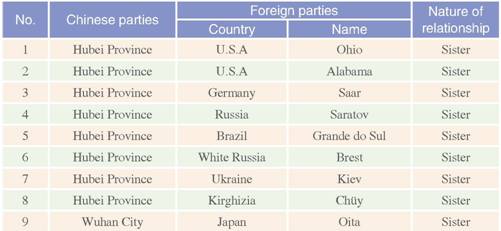
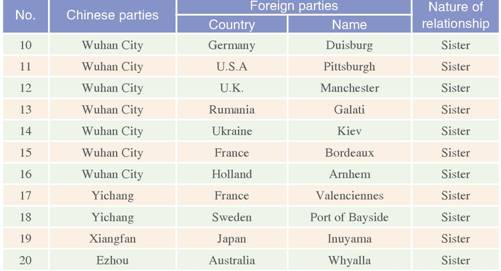
International Exposition and Conferences China International Machinery and Electronic Products Exposition (CWME for short)
CWME is a state-level, international and professional exposition, co-sponsored by the Ministry of Commerce of the People’s Republic of China, China Council for the Promotion of International Trade, Shanxi Provincial People’s Government, Hunan Provincial People’s Government, Hubei Provincial People’s Government, undertaken by Wuhan Municipal People’s Government, and cosupported by China Machinery Industry Union, China Chamber of Commerce for Import and Export of Machinery and Electronic Products and the Export-import Bank of China. Since 2000 CWME has been crowned with success for the past six sessions. CWME has attracted about one thousand manufacturers from 50 more countries and regions, and 2,000 more machinery and electronic enterprises in China and 200 more thousand professionals in Wuhan for negotiation and sharing of opportunities and achievement in trade and investment in the past six years.
Conference on Overseas Chinese Pioneering & Developing in China
Conference on Overseas Chinese Pioneering & Developing in China (COCPDC for short) is co-sponsored by Overseas Chinese Affairs Office of the State Council of the People’s Republic of China, Hubei Provincial People’s Government and Wuhan Municipal People’s Government. With exchange, cooperation, business developing and development as the objects, the Conference aims at promoting the combination of technology and capital of overseas Chinese and mainland Chinese, helping the overseas Chinese to start their business, facilitating the exchange and cooperation of the foreign countries with Hubei Province, and realizing mutual development on the basis of reciprocity. The 5th Conference on Overseas Chinese Pioneering & Developing in China and the 3rd Hubeinees Fellowship were held in August 2005 in Wuhan. More than 500 overseas Chinese, overseas Chinese businessmen and persons in charge of Hubeinees Fellowship attended the conference. 121 contracts were signed with the total investment of more than RMB 3 billion, the contracted capital being RMB 840 million, and there were 49 projects for introducing talents and technologies.
(vi)Higher Education and Scientific Research
There are 85 institutions of higher learning in Hubei Province. In 2005, there were 1,086,000 undergraduate students in Hubei Province.
In Hubei Province, there are more than 1,300 institutions of various kinds for research and development, 1 state lab, 14 state key labs, 15 state engineering (technology) research centers, 14 state enterprise technology centers, 11 state high-technology innovation centers, 1,130,000 professional technicians, 52 academicians of Chinese Academy of Sciences and Chinese Academy of Engineering.
In 2005, 717 scientific achievements of or above provincial level were obtained. 11, 131 technology contracts were signed, with the actual contracting sum of RMB 5,018 million. It presided over 54 scientific and technological projects and 42 projects of“863”Program, as well as 22 State High-technology Development projects, with the total investment on the projects of RMB 1,130 million.
(vii)Tourism
Places of interest With beautiful scenery and many historical sites, Hubei Province is rich in tourism resources. The famous Three Gorges
is the first in the list of top 10 famous places of interest. The East Lake, Wudang Mountain, Dahong Mountain, Longzhong
and Jiugong Mountain are key places of interest of the state. Shennongjia, Wudang Mountain and Mausoleum of Ming Emperor are listed in“Man and Nature Protection Zone Program”and“World Cultural Heritage”by UNESCO. 80 chapters of the 120 chapters of the masterpiece“Three
Kingdoms”involve Hubei Province.
In 2005, the Province welcomed 77,125,700 tourists, with the revenue from tourism totaling RMB 47,315 million Yuan as the best in history.
Specialties in Hubei Hubei Province is abundant in specialties, among which are Wuchang Fish, Jingshan Guobao Qiao Rice, Zigui Navel Oranges, Luotian Chestnuts, Honghu Lotus Root, Xianning Sweet Osmanthus, and Xiaogan Matang of unique flavor.
II . Economy
(i)GDP
2000-2005 GDP of Hubei Province and the Growth Rate
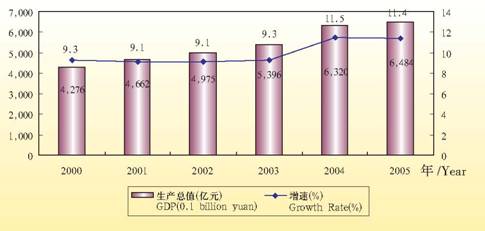
(ii) Data of Natural Resources, Industry and Agriculture
Natural Resources
All kinds of natural resources abound in Hubei province, with all its beautiful scenery and mountainous geographical conditions. 138 types of minerals have been found in Hubei, taking up 81% of all discovered minerals nationwide. Among the 138 types of minerals, the reserves of 89 types have been ascertained, for instance, the reserves of five mineral resources including peridotite for fertilizer, iodine, garnet, rectorite clay and diabase for construction use rank top nationwide; the reserves of 17 mineral resources such as marlite, phosphorus etc. are No.2 or 3 all around China; also the reserves of 35 resources such as iron, copper, gypsum, gold, mercury and manganese rank 4th-10th nationwide.
There are various kinds of animals and plants in this province, with a number of world-rare species and species only can be found in Hubei. The province is also a key base of traditional Chinese medicine, thus called the “China’s herb warehouse”. It boasts abundant water resources which is capable of generating 31.334 million KW of electricity. The installed capability developed or under development is 27.268 million KW, ranking top nationwide. The Three Gorges Project, presently the largest water-control project in the world, is located in Hubei province, with total installed capability of 18.2 million KW.
Industry
Hubei has a firm foundation and comprehensive supporting strength for such industries as auto manufacturing, metallurgy, machinery, electric power, chemical industry, electric information, textile and building materials. It is one of China’s three iron & steel bases, with the largest manufacturing capability for medium, thick and thin plates as well as special steel. It is the second largest auto manufacturing base and the largest manufacturing base for medium lorry, heavy-duty machine tools and packing machinery, also for such chemical products as hydroelectricity, alkali, pesticide, phosphorus, salt & chemical and fiber paste. Also Hubei is one of China’s photoelectron information industrial bases, modernizedmanufacturing base for traditional Chinese medicine and a key textile base.
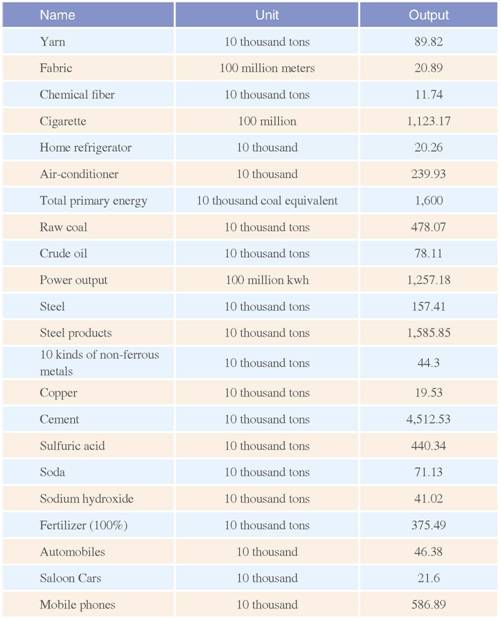
Fix Assets Investment
In 2005, RMB 283.475 billion Yuan has been invested in fix assets in the whole province, among which investment in real estate development is RMB 47.795 billion Yuan. If classified based on economic types, state-owned investment is RMB
109.571 billion Yuan; collective investment is RMB 7.947 billion Yuan; urban and rural individual investments total RMB 55.427 billion Yuan; other economic investment is RMB 110.53 billion Yuan. According to industry types, the three types of industries have invested respectively RMB 9.288 billion Yuan, RMB 108.805 billion Yuan and RMB 165.382 billion Yuan.
RMB 49.5 billion Yuan has been invested in the 64 key construction projects. Newly added production capabilities include: hot-rolled steel of 500 thousand tons per year, raw coal exploitation of 1.1978 million tons per year, electric-power capacity of 2.76 million KW, steel-making of 3.36 million tons per year, and also newly built highway of 296.14 kilometers, program-controlled exchange of 34.3 thousand per year.
Agriculture Known as the“land of fish and rice”, Hubei is one of the key production bases for commodity grain, cotton and oil and the largest production base for fresh water products. The outputs of rapeseed and freshwater fish rank No.1 nationwide, cotton and rice also on the top level, and there is great potential for the production and processing of agricultural and sideline products.
In 2005, grain-planting area was 3.9268 million hectares; cotton planting area 390.3 thousand hectares,; and oil plants area 1.4506 million hectares. Total grain output was 21.7738 million tons; total cotton output 375.0 thousand tons; and oil plant output 2.9390 million tons (see the following table for outputs of major agricultural products).
Total forestation area was 186.4 thousand hectares in Hubei. Timbers harevested was 1.36 million cubic metres.
Stock raising and fishery have kept growing steadily, with total meat output of 3.4263 million tons and water products of
3.182 million tons, a record-breaking output.
Power consumption in the countryside was 6.845 billion kwh. And fertilizer consumption was 2.8363 million tons.
Outputs of Major Agricultural Products in 2005
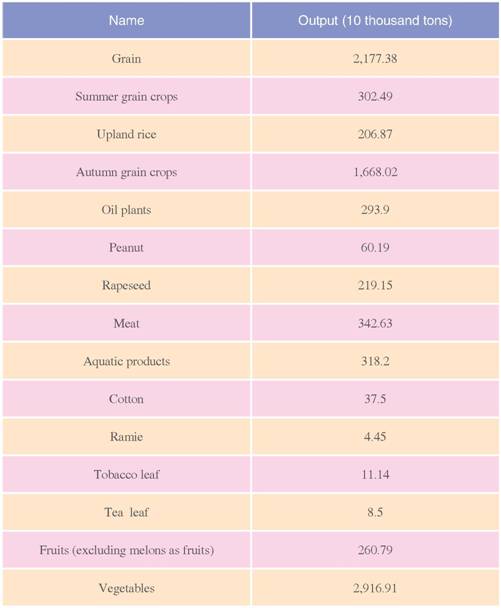
Advantageous Industries As one of the cradles of China’s modern industry, Hubei is also one of the key industrial bases in China. It has built a characteristic industrial system with its advantages in resources all through the years, featuring electronic information, auto manufacturing, iron & steel, and textile manufacturing.
“China Optical Valley, Wuhan”has been rapidly developed into China’s largest photoelectron information center through development of photoelectron information technologies and optimization of industries, talents and resources. In the past 10 years, the “China Optical Valley”has been growing steadly, which has attracted concern of people.
The gross output of machinery and auto industries of Hubei province has reached RMB 140.7 billion in 2005, with added value of RMB 40 billion, sales income of RMB 145 billion, gross profit and tax turnover RMB 12.6 billion. The total profits reach RMB 5.66 billion and the export value is RMB 2.69 billion.
By the end of 2005, the manufacturing capability of complete cars reach 800 thousand, with the characteristics of
“car, heavy, medium, light and special vehicles”developing simultaneously, with a complete set of“high, medium and low level”vehicles. Stimulated by the rapid development of complete cars, the parts and components section has expanded gradually, with over 700 such enterprises (among which 310 are large and medium-sized), providing a supporting capability for 600 thousand vehicles. Hubei province has a nnmber of large-scale enterprises of auto omponents and parts, which grasp 58 kinds of volnme production of 60 key components and parts maily supported by the state. These enterprises are famous and play an important role in China. For example, CAAS that is established on the basis of Henglong Jingzhou and three other enterprises through reversed takeover and become the first Chinese enterprise to be listed on NASDAQ in the United States, the listing of Dongfeng auto shares in China’s mainland, as well as the listing of Dongfeng Group in Hong Kong.
In 2005, there are 433 large and medium-sized auto enterprises in Hubei province, including 9 for complete vehicles, 63 for vehicles refitting (3 of which also possess complete vehicles), and 361 for auto components and parts. The total assets are RMB 134.5 billion, with gross industrial output of RMB 79.92 billion, sales income of RMB 95.05 billion, and profits payment and tax turnover RMB 8.825 billion, and profits of RMB 3.548billion. 389.4 thousand automobiles are manufactured, among which there are 141.7 thousand cars. By the end of 2005, there are 193 joint ventures in the auto industry in Hubei, with total investment of US$ 6,365.7732 million and contracted foreign investment of 1,722.215 million US$.
By the end of 2005, the textile industry of Hubei province has a capacity of 7 million ingots and 70 thousand looms. Large and medium-sized enterprises have the manufacturing capacity of 880 thousand tons of yarn, 2.1 billion meters of cloth and 200 million pieces of garments, with total industrial value of RMB 44 billion, sales income RMB 40 billion and profit payment and tax turnover RMB 1.9 billion. There are 73 state-owned and state-holding textile enterprises; large and medium-sized private enterprises take up 90%, while state-owned and state-holding enterprises take up 37.8% of total assets, Drivate economy plays a“leading role”in Hubei textile industry.
Sevrice Industry
Ever since the reform and opening up, the service industry of Hubei has entered into a period of all-around, rapid and sustainable development. The workforce of the primary industry and the secondary industry is basically steady. More than 3 million people enter into the service industry for the first time, 300 thousand per year. The service industry become a majoy channel of employment.
(iii)Business Data
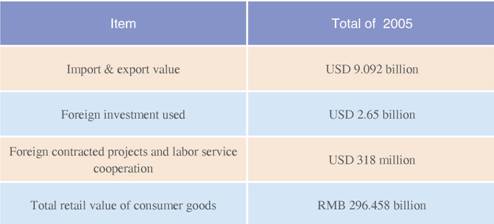
Business Volumes with Major Importing and Exporting Countries
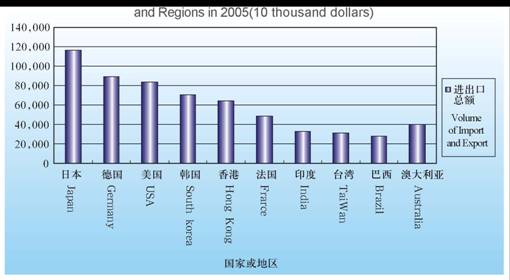
Pattern of Opening up. In 2005, there are 108 development zones, 3 of which are state-level, and other 105 are provincial level. 3 cities are opened up to the outside, together with one international airport, 15 bonded warehouses Station. There are 13 ports opening up to the outside world, which includes Wuhan Port, Huangshi Port, Yichang Port, Shashi Port, Ezhou Port, etc. Wuhan Customs House is administrative authority supervising import & export in Hubei province, with 7 affiliated customs agencies. Hubei Import & Export Commodity Inspection Bureau, with 8 branch offices, is responsible for the inspection of imported and exported commodities as well as plants and animals.
Internatioral Trade. The import & export value of the year 2005 was 9.092 billion dollars, in which export value amourts to 4.45 billion dollars. The growth rate of import & export and growth rate of export are ranked 4th and 9th in the whole country and first and second in Central China. The exports of iron & steel, ship building, auto and components, electronics, chemical engineering and other advantageous industries are growing powerfully.
Import & Export of Hubei Porvince from 1990 to 2005(10 thousand dollars)
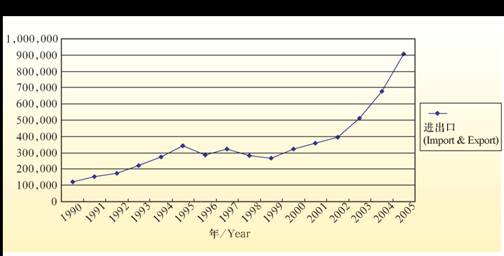
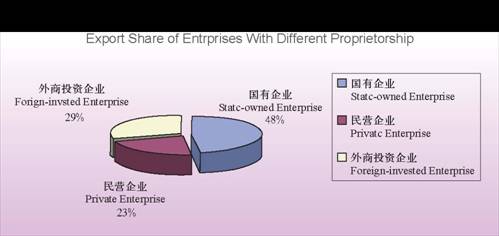
Major Sources of Foreign Investment by the end of 2005
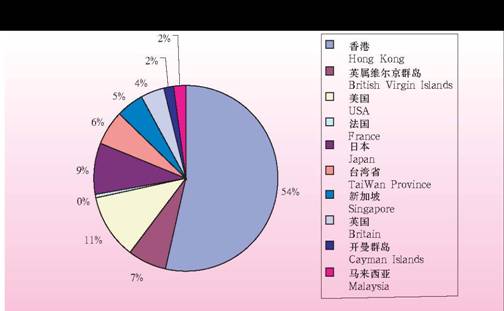
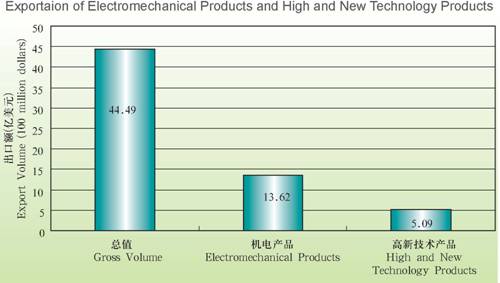
Utilization of Foreign Investment. The actually used foreign investment in 2005 is 2.65 billion dollars. There are 520 projects with foreign direct investment, totaling contracted capital of 2.11 billion dollars, and actually used foreign investment of 2.185 billion dollars. Total taxation by foreign invested enterprises reaches RMB7.67 billion. There are 314 thousand employees in foreign invested enterprises.
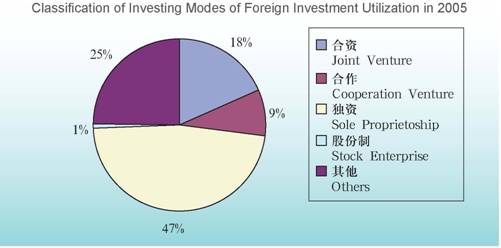
Geographic Distribution of Foreign Contracted Project Turnover Of Hubei Province in 2005
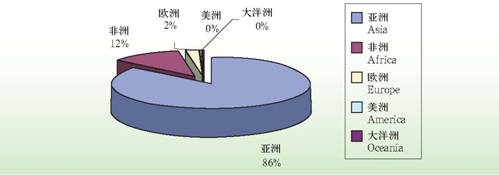
Gross Retail Volume and Growth Rate of Social Consumer Goods of Hubei Province from 2000 to 2005
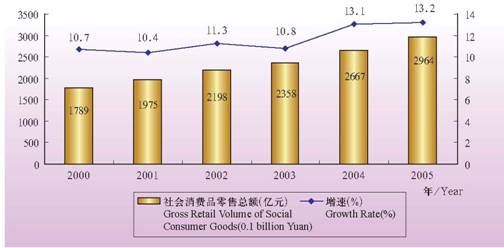
Expansion of Foreign Economic Cooperation Scale. Total turnover of foreign economic cooperation in 2005 has reached 318 million dollars; overseas labors reach 5,658 including 1,994 mariners. At the end of the year 2005, 7,599 labors stayed abroad. There are 19 newly sanctioned overseas economic support projects. 10 overseas investment enterprises are newly authorized, with contract investment of 5.37 million dollars, in which Chinese investment is 5.21 million dollars, involving resource development, exploration and design, as well as manufacturing and processing, playing a proactive role in Hubei’s overseas economic development.

Domestic Trade Keeps Growing. Retailing of social consumer goods in 2005 reaches RMB 296.458 billion, total turnover of wholesale and retail trades reaches RMB 240.235 billion, and the catering industry has total turnover of RMB 38.665 billion.
III . Investment
(i)Policy and Administrative Rules
Catalogue of Related Laws
Foreign Trade Law of the People’s Republic of China
Customs Law of the People’s Republic of China
Law of the People’s Republic of China on Import and Export Commodity Inspection
Law of the People’s Republic of China on Chinese-Foreign Equity Joint Ventures
Law of the People’s Republic of China on Chinese-Foreign Contractual Joint Ventures
Law of the People’s Republic of China on Foreign-Capital Enterprises
Company Law of the People’s Republic of China
Law of the People’s Republic of China on the Entry and Exit Animal and Plant Quarantine
Law of the People’s Republic of China on Control of the Entry and Exit of Aliens
Law of the People’s Republic of China on the Control of the Exit and Entry of Citizens
Securities Law of the People’s Republic of China
Income Tax Law of the People’s Republic of China for Enterprises with Foreign Investment and Foreign Enterprises
Individual Income Tax Law of the People’s Republic of China
Law of the People’s Republic of China on the Administration of Tax Collection
Environmental Protection Law of the People’s Republic of China
Law of the People’s Republic of China on Evaluation of Environmental Effects
Law of the People’s Republic of China on Promotion of Cleaner Production
Law of the People’s Republic of China on Prevention and Control of Desertifi cation
Marine Environment Protection Law of the People’s Republic of China
Law of the People’s Republic of China on the Prevention and Control of Atmospheric Pollution
Law of the People’s Republic of China on Prevention and Control of Environmental Pollution by Solid Waste
Law of the People’s Republic of China on Prevention and Control of Water Pollution
Law of the People’s Republic of China on Prevention and Control of Environmental Noise Pollution
Law of the People’s Republic of China on Prevention and Control of Radioactive Pollution
Frontier Health and Quarantine Law of the People’s Republic of China
Labour Law of the People’s Republic of China
Trade Union Law of the People’s Republic of China
Searching Website for the Related Laws
1 . Searching System of Law sand Regulations of China (website of National People’s Congress of China)
http://law.npc.gov.cn:87/home/begin1.cbs
2. China Legislative Information Network System
http://www.chinalaw.gov.cn/jsp/jalor/index.jsp
3. Ministry of Commerce
http://www.mofcom.gov.cn
the above-mentioned websites are for reference only.
(ii)List of Predominant Industries for Foreign Investment in Hubei
1. Storage, fresh-keeping and processing of grains, vegetables, products of poultry & livestock and aquatic products
2. Forestation and import of forest of fi ne variety
3. Comprehensive utilization of bamboos
4.Rational exploitation, utilization and protection projects of water resources
5. Aquiculture and deep-processing of aquatic products
6. Technical innovation for cotton textile and Dyeing & Printing
7. Processing of cloth and top grade clothing
8. Construction and management of highway, independent bridges and tunnels
9.Construction and management of wind power station
10. Exploitation of phosphate ore, production of high-analysis phosphate and chemical product of phosphate & salt
11. Manufacture of auto parts
12. Manufacture of large environmental protection equipment
13. Development and manufacture of new electronic components
14. Exploitation and deep-processing of graphite
(iii)Procedures for Enterprise Establishment
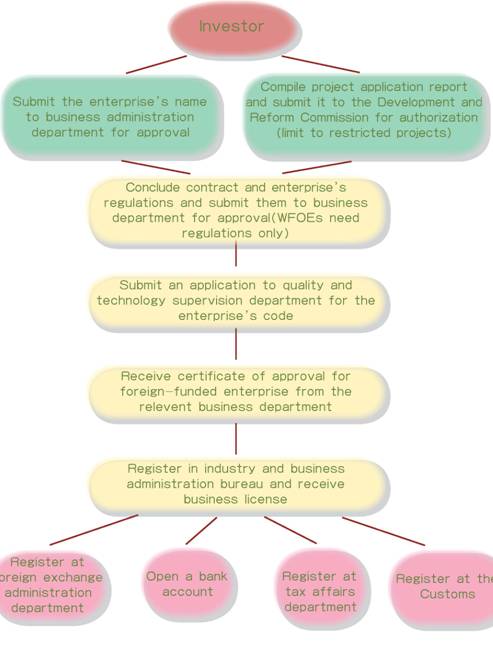
(iv)Living Environment
Living environment in Hubei is good. By the end of 2005, the urbanization rate in Hubei reaches 33%, and the forest coverage rate reaches 45.97%. The waste disposal capacity increases to 14,700 tons per day. from 13,500 tons per day in 2003, which reaches the standard of no harm or almost no harm. The concentrated disposal rate for household waste reaches 61%. There are now 32 household sewage disposal sites, with the
disposal capacity at 2,074,500 tons per day. In 2005, the air quality is improved. Among the 17 key cities of the province, the up-tostandard rate of air quality is 65%, increased by 18% compared with the previous year.
Medical & Sanitation. There are 566 hospitals, and 95,186 berths in the province. There are complete systems of public health such as the disease control center. The study on cardiovascular, otolaryngology, and oral cavity is on top.
(v)Reference Prices of Basic Elements
Price of Water, Electricity, and Land in Hubei Province in 2005

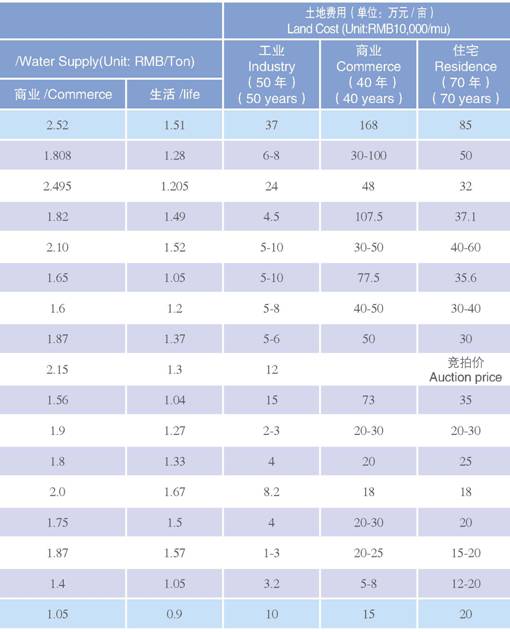
Summary of Hubei Labor Force Salary in 2005
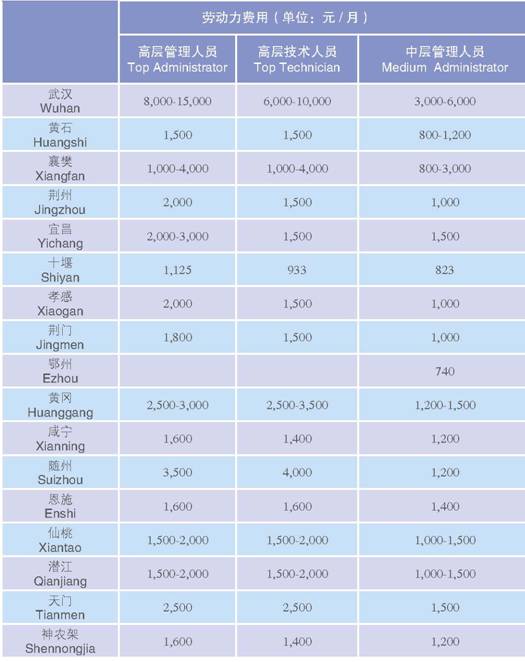

IV . Development Zones
(i)National-level and Provincial-level Development Zones
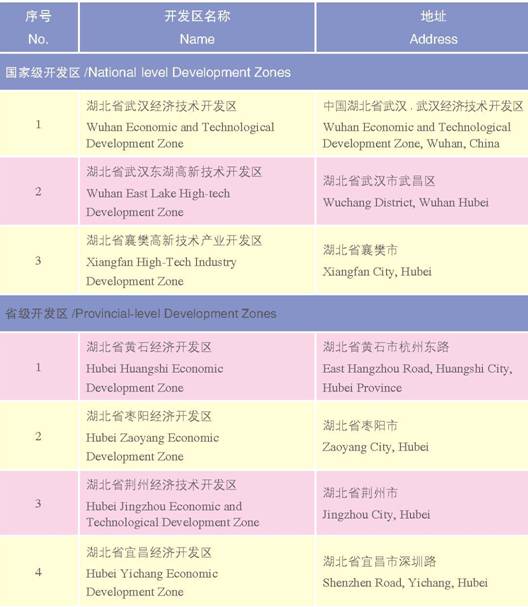
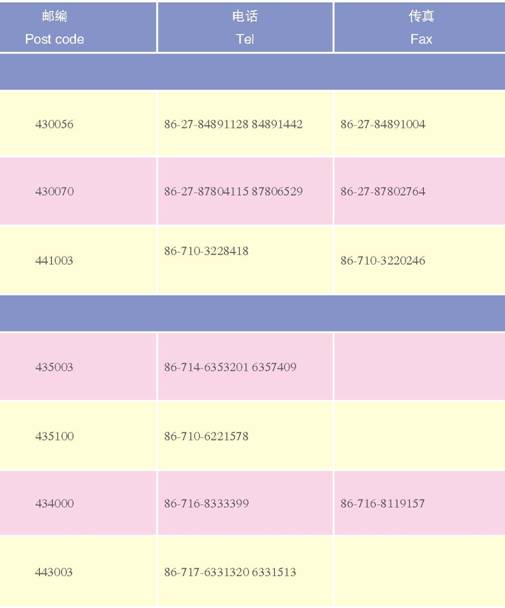
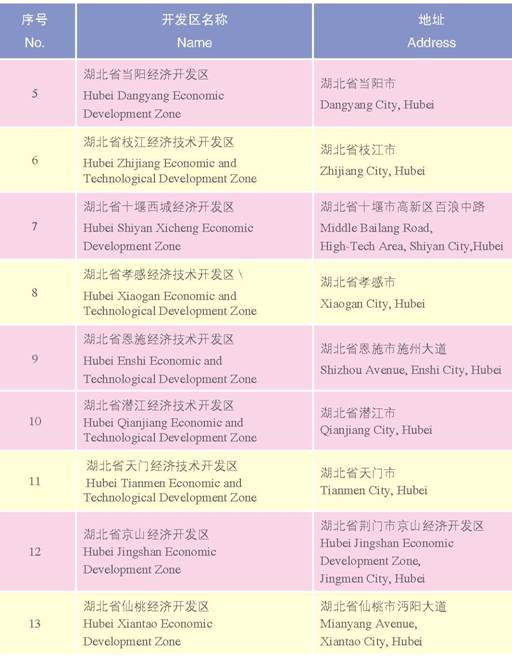
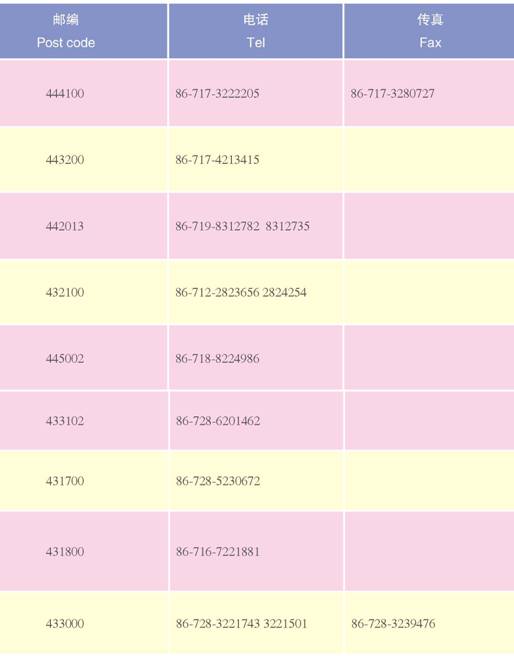
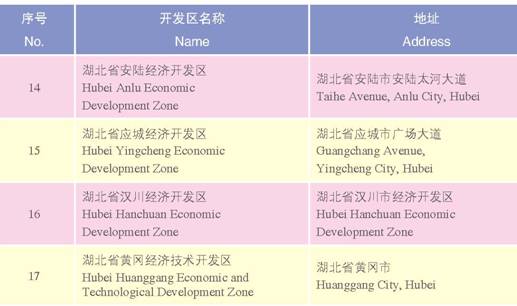
(ii)Relevant Institutions
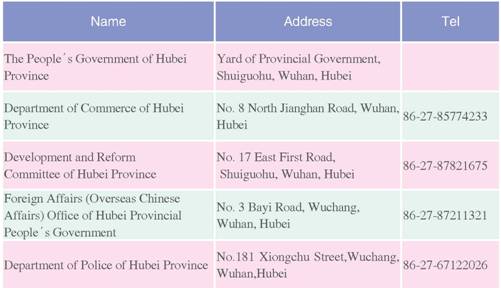
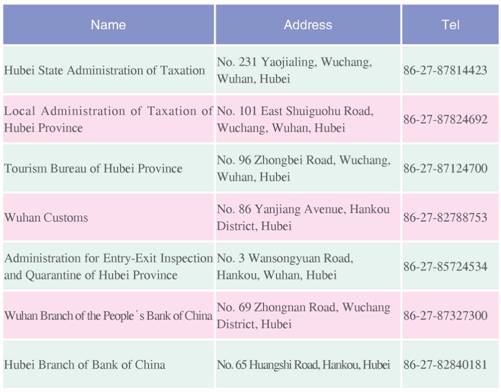
(iii)Relevant Websites
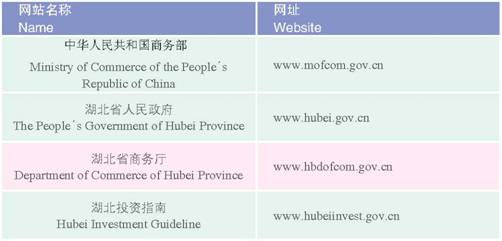
Appendix
Well-knownHotelsandRestaurants
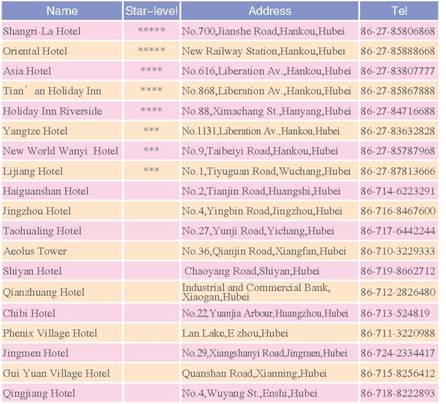
Emergency Telephone Number
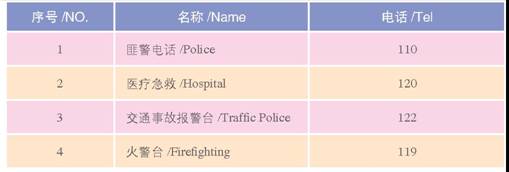
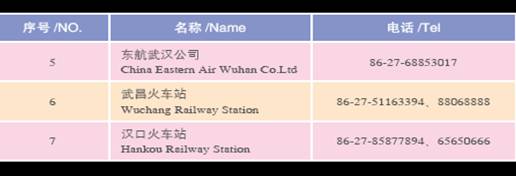
(Ministry of Commerce)